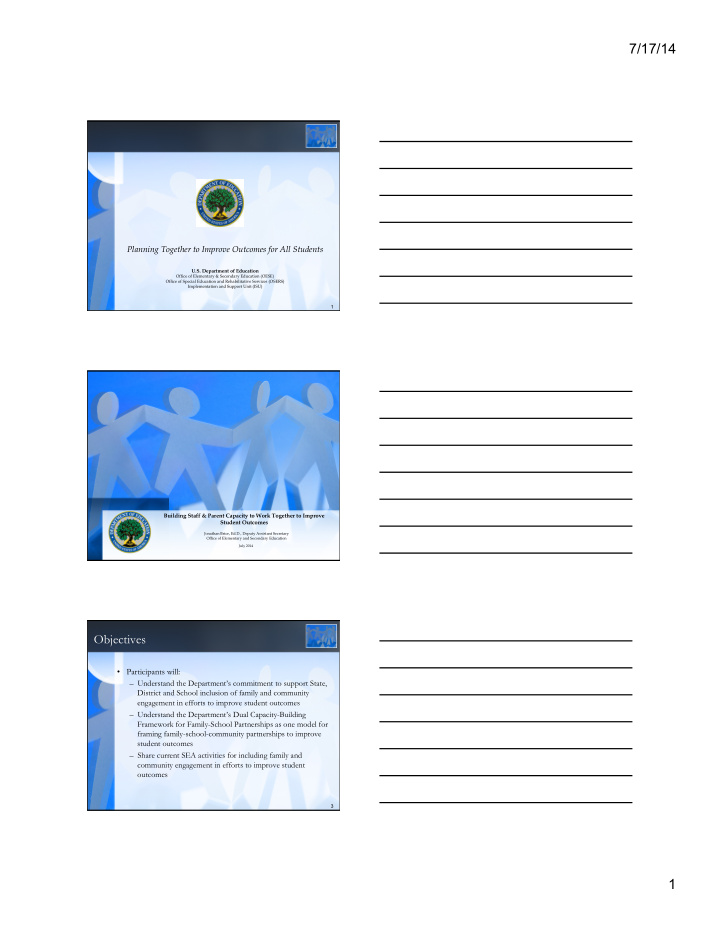



7/17/14 Planning Together to Improve Outcomes for All Students U.S. Department of Education Office of Elementary & Secondary Education (OESE) Office of Special Education and Rehabilitative Services (OSERS) Implementation and Support Unit (ISU) 1 Building Staff & Parent Capacity to Work Together to Improve Student Outcomes Jonathan Brice, Ed.D., Deputy Assistant Secretary Office of Elementary and Secondary Education July 2014 Objectives • Participants will: – Understand the Department’s commitment to support State, District and School inclusion of family and community engagement in efforts to improve student outcomes – Understand the Department’s Dual Capacity-Building Framework for Family-School Partnerships as one model for framing family-school-community partnerships to improve student outcomes – Share current SEA activities for including family and community engagement in efforts to improve student outcomes 3 1
7/17/14 The Power of Family & Community Engagement • Everyone has a shared stake in the outcomes of future generations, and thus, supporting family and community engagement is a critical aspect of improving our nation ’ s schools. • The question is how can the federal government and state education agencies better support the work that is currently being done to incorporate family and community engagement into efforts to improve student outcomes? 4 Federal Programmatic Commitments • Title I Part A, Section 1118 • Title III, Section 3302 • ESEA Flexibility, FAQs: A-16 • SIG • McKinney Vento -Homeless Education • Title I Part D- Neglected & Delinquent • Individuals with Disabilities Education Improvement Act of 2004 5 • It’s important to you because you are already Defining Engagement • Shared responsibility in which schools and other community agencies and organizations are committed to reaching out to engage families in meaningful ways and in which families are committed to actively supporting their children’s learning and development, • Continuous across a child’s life and entails enduring commitment but changing parent roles as children mature into young adulthood, • Cuts across and reinforces learning in the multiple settings where children learn— at home, in pre-kindergarten programs, in school, in after school programs, in faith-based institutions, and in the community. Harvard Family Research Project (2009): http://www.hfrp.org/publications-resources/browse-our-publications/redefining-family-engagement-in- education 6 2
7/17/14 Critical Shift: From Involvement to Engagement Theory of action - • If SEAs support districts and schools: – in engaging families and communities in the shared responsibility of setting goals for desired outcomes and then including them in strategizing to implement actions to achieve those results • Then, – Students will continue to earn better grades, enroll in higher-level programs, have higher graduation rates, and more likely to enroll in postsecondary education. – Students will be supported in staying in school longer, and like school more. – Families and school staff can continue to work together to bridge the gap between children from diverse cultural backgrounds and school cultures. Henderson, A. T., Mapp, K., Johnson, V. R., & Davies, D. (2007). Beyond the bake sale: The essential guide to family- school partnerships . New York: The New Press. 7 Dual Capacity-Building Framework for Family-School Partnerships • The Dual Capacity- Building framework provides one model that states, districts and schools can use to guide their efforts for tapping into the rich resources that engaged families and communities can bring to improving student outcomes. 8 The Challenge 9 3
7/17/14 Opportunity Conditions 10 Policy and Program Goals 11 Family and Staff Capacity Outcomes 12 4
7/17/14 Opportunity Conditions - Process • Linked to Learning – Initiatives are aligned with school and district achievement goals and connect families to the teaching and learning goals for the students. – Families and school staff are more interested in and motivated to participate in events and programs that are focused on enhancing their ability to work as partners to support student outcomes. 13 Opportunity Conditions - Process • Relational – A major focus of the initiative is on building respectful and trusting relationships between home and school. – The relationship between home and school serves as the foundation for shared learning and responsibility and also acts as an incentive and motivating agent for the continual participation of families and staff. 14 Opportunity Conditions - Organizational • Systemic – Initiatives are purposefully designed as core components of educational goals such as school readiness, student achievement, and school turnaround. – Family-school partnerships are seen as essential supports to school and district improvement and are elevated to a high priority across state, district, and school improvement plans. 15 5
7/17/14 Sharing/Planning for Building Family-School Partnerships 1) What does your state 2) What data drove you to 3) What data does this 4) How can the federal have in place to address implement this program program or activity yield government assist in family engagement to or activity? (data) to help you know that you supporting your family improve student have reached your goals? engagement efforts? outcomes? (results) (infrastructure) 16 Questions? 17 Dr. Jonathan Brice Deputy Assistant Secretary Office of Elementary and Secondary Education U.S. Department of Education 202-260-1470 jonathan.brice@ed.gov 18 6
Recommend
More recommend